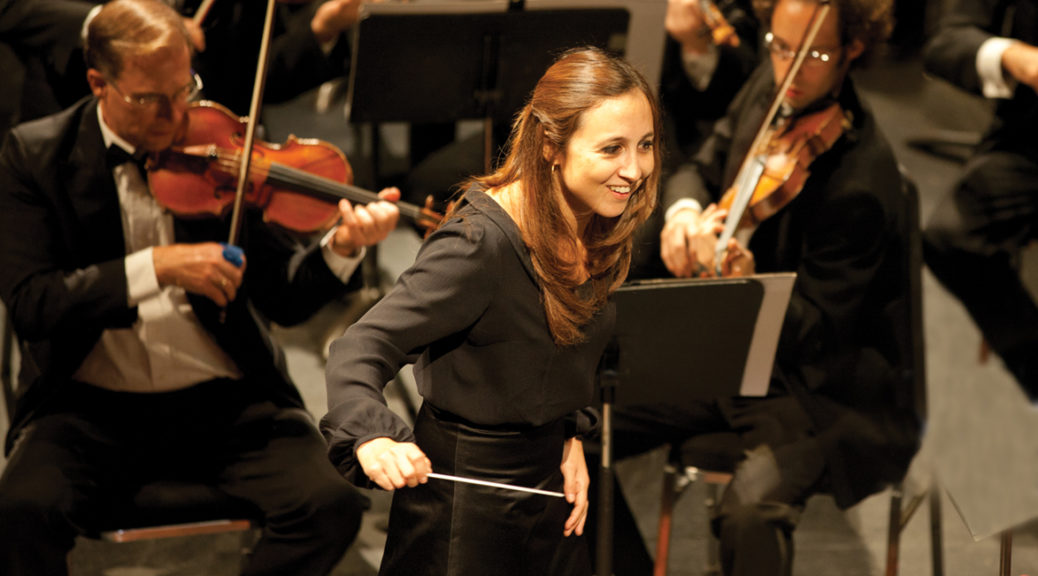
GOOD THINGS COME IN THREES
Byword for the New Podium Mom with Triplets
After a considerable 2016-17 absence given the birth of her triplets, Music Director Joana Carneiro was back on the podium this week looking as fit as a Guarneri fiddle. It’s a Bay Area first: There’s no record of any symphony conductor here ever having borne triplets and then returning to the podium.
Her program at the Berkeley Symphony was unusual, with an avant-garde world premiere, an early Beethoven, and modern pieces requiring rounding up a quartet of saxophones.
Carneiro was on top of the program, smiling nonstop at musicians, using broad baton strokes, and wheeling about on the podium as if dance could be her next career. She plunged into the works with gusto and made even the pot-boiler Beethoven First Symphony seem like a commendable, stimulating exercise, even if weighted down with overachieving brass.
Two audacious novelties highlighted the concert Oct. 5. The Shostakovich Jazz Suite No. 1 (1934) provides one of the true rarities: A jazz waltz, and a good one at that. The second part has a derivative March-of-the-Toy-Soldiers lilt, notable mostly for the refined soprano sax work of soloist Patrick Posey. There’s even a Hawaiian guitar, coming from a part of the world that was totally unfamiliar to the Soviet composer.
John Adams’ heavily minimalistic “Fearful Symmetries” (1988) got a warm reception, as much for the personal appearance of the popular Berkeley composer as for the half-hour-long work itself. The problem of minimalism is like that of the head of the camel in the old Arabian saying: Do not let the head enter the tent, or the whole tent will collapse. Minimalist composition with endless ostinatos is so seductive, it can run away with a work entirely, as here, prompting a composer to create a work twice as long (and much more repetitious) as really effective. The catchy and very rhythmic opus sweeps one along like a raging river in a flash flood, showing off the rock-solid trio of BSO trombones.
The new 17-minute Cello Concerto by the Australian William Gardiner, 30, is brief and puzzling. It starts off like Kyoto temple music, with a duet of wood blocks and (plucked) cello pizzicato, as if to break all the conventional rules, with high flutes joining in for a sonic canopy. The solo cello (by Tessa Seymour) ruminates a lot near the low C, while the orchestra focuses on a continuum sound.
In the other movement come ear-tweaking sounds, and tubular bells, while the cellist goes to high fingerboard positions. A suggestion of chamber music evolves with the unique cello pairing opposite the trombones. The orchestra serves up many momentary episodes that come and go like a will-o-the-wisp. Seymour’s cello comes back with what seem like laid-back improvisations, and later emphatic hard strokes, as if to saw the instrument in two before the abrupt ending. The composer attended and took bows.
Seymour finally got a chance to show her mettle in the solo encore, Giovanni Sollima’s “Lamentatio,” a highly virtuosic flight in which the cellist sings along with her play.
The Beethoven was animated and resonant, sounding very solid apart from some blurring in the woodwinds. This is an orchestra of which the city of Berkeley can be proud, doubly so given the political frictions of recent months.
CALL FOR MR. PAGE TURNER!—Because the parts of scores are all different, some impossible page-turns can bedevil musicians. The BSO solved that, in the Adams: A percussionist, lacking an instant to do it himself, had a violinist with a rest sneak over, flip the page, and return to his seat.
A BSO innovation this year is repeating certain concerts at the S.F. Conservatory of Music the following night, just a couple of blocks away from the home of the S.F. Symphony. Competition!?
BERKELEY SYMPHONY, Joana Carneiro conducting, with Gardiner world premiere. Oct. 5, Zellerbach Hall, Berkeley; Oct. 6, S.F. Conservatory. For BSO info: (510) 841-2800, or go online.
—BERKELEY